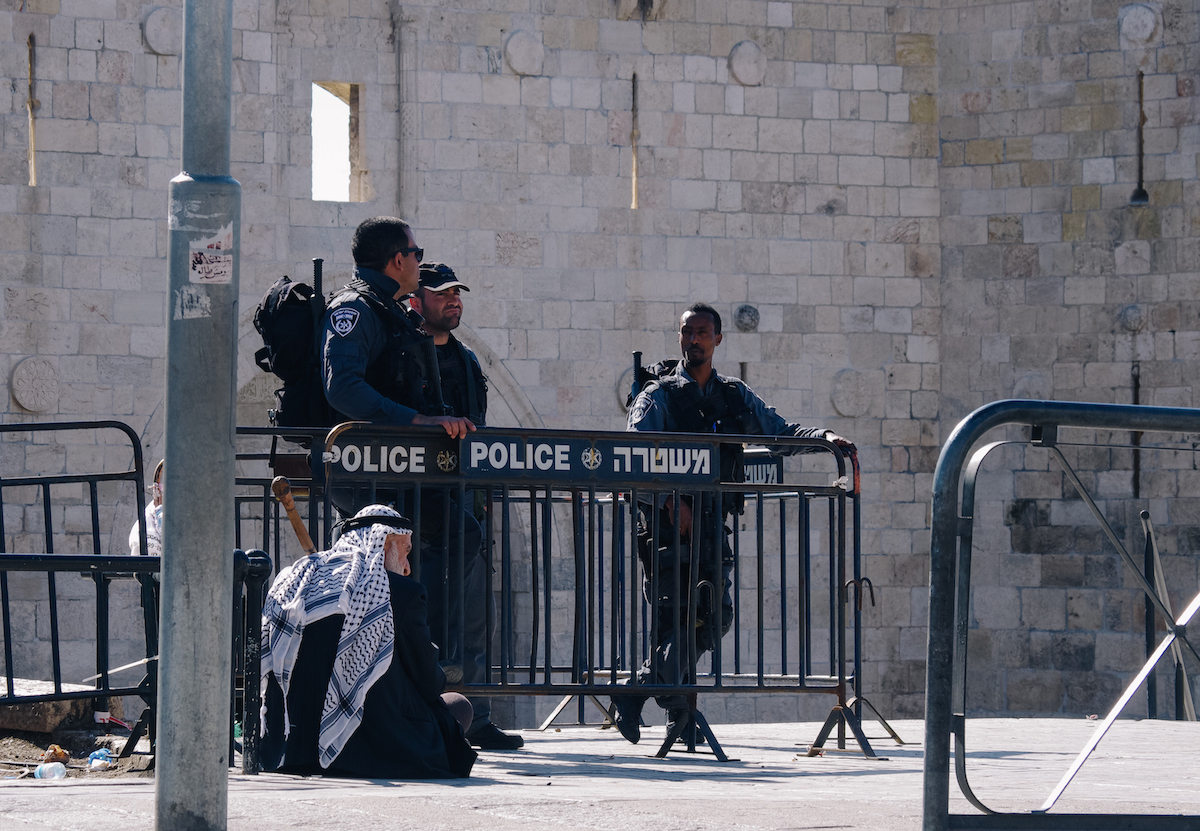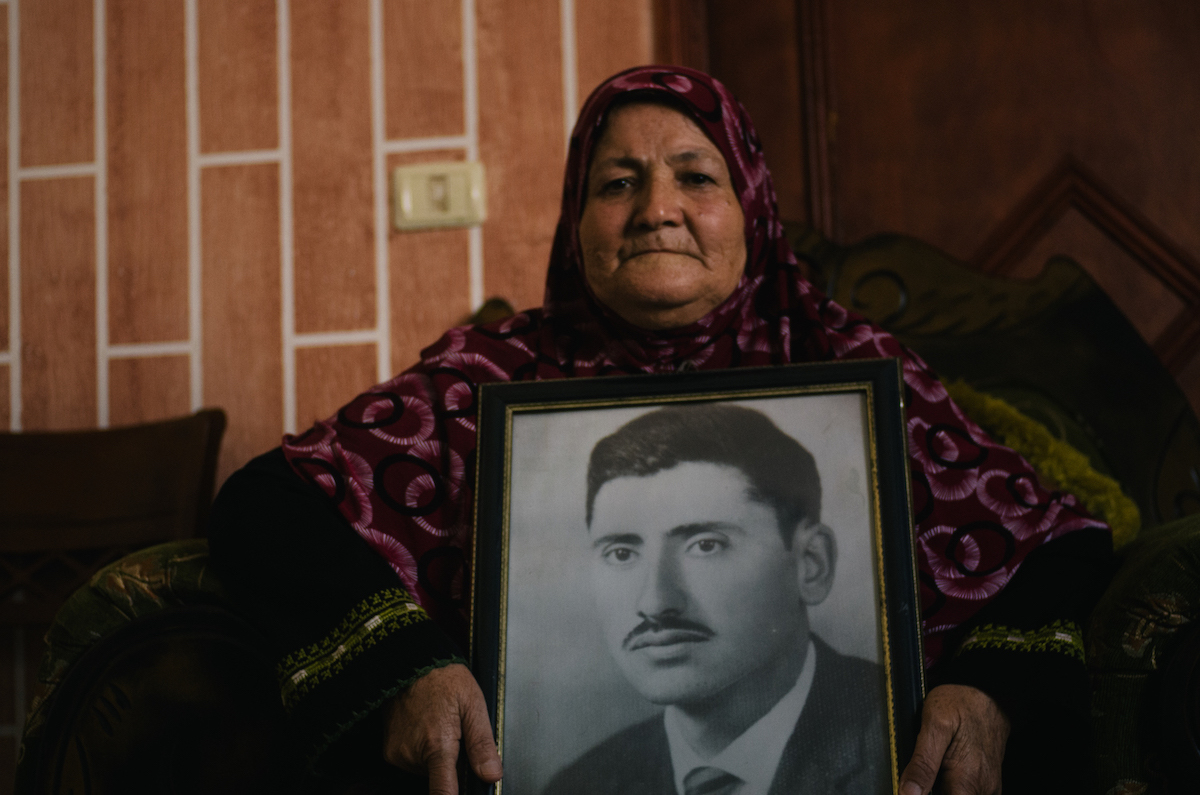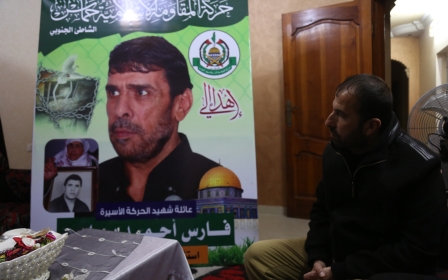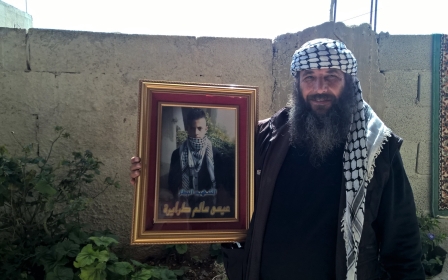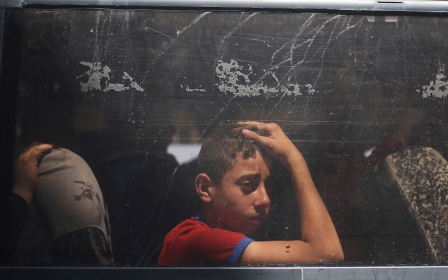Mourning the missing in Israel's 'cemeteries of numbers'

His body was lifeless but still warm, limbs bouncing above the crowd that carried him. The blood that had almost drained from his face instead dried on his cheek, smeared below the right eye.
The tinny loudspeakers of local mosques blared the news: Mohammed Abu Ghanam had been killed. His friends bore him on their shoulders, storming uphill towards the neighbourhood cemetery where a grave had already been opened.
Moments earlier on 21 July 2017, Israeli forces had raided al-Maqassed hospital on Jerusalem's Mount of Olives in search of 19-year-old Abu Ghanem, who lay dying after being shot in a protest against restrictions at Al-Aqsa mosque. His neighbours smuggled his body through the back of the hospital and over a wall, skirting the Israeli cordon to sneak him back up the other side of the hill.
As they lowered him into the grave, tear gas canisters hissed in the air, but Israeli police ventured no further inside, deciding to give up their chase. Abu Ghanam's friends had won the race to bury him before Israeli forces could confiscate his body.
Had they failed, he would have joined some 253 Palestinians kept in the Israeli burial sites and morgues known as "cemeteries of numbers".
Named after the numbering system that replaces names on graves, the cemeteries are part of a loaded mourning process disrupted when bodies are confiscated after alleged attacks or clashes. Families face long legal battles for their release which, in the best case, end with a midnight handover on condition that funerals are silent and attended by no more than a few dozen mourners.
They have no right at all to imprison the bodies of even an enemy
- Rashida, sister of Dalal Mughrabi
Others are never returned. According to court documents and lawyers, at least 45 Palestinians are missing from those cemeteries - many held since the aftermath of Israel's 1967 occupation of East Jerusalem, the West Bank and Gaza.
Responding to a High Court order for their return, the Israeli military said it had "exhausted" all methods and failed to find nine of the bodies. The remaining 36 have not been found after initial searches, but their eventual return has not been ruled out, according to the Jerusalem Legal Aid Center (JLAC), which is fighting a legal battle over 116 bodies.
The policy has evolved over decades and Israel defends it as a deterrent to violence. Palestinians say it deprives families the right to mourn their dead.
In August, some of those involved marked 10 years of their push for the bodies to be returned. For years, many have known nothing about the fates of their relatives - including whether they were actually dead or not.
'People were afraid to ask'
Up near the hills of the northern West Bank, the sleepy town of Majdal Bani Fadel was ideally located for Issa Masleh to operate in the Palestinian armed resistance against Israel after the 1967 occupation.
From his hometown, he could easily cross to Jordan to meet with Fatah leaders based there. That changed when the Israelis discovered his cell, forcing him to live in the hills where his wife would bring him food and supplies, until the cell was ordered to move away from the area. They were found by the Israelis as they were moving, on 5 September 1969, and Masleh was killed in the fighting.
"From that day on we haven't received any [official] information about the body," Masleh's son Ashraf, who was a child at the time, told Middle East Eye.
The family heard from locals that Masleh was dead but never received any confirmation. It was only after Ashraf himself was imprisoned, during the First Intifada, that he learnt the full story from his father's still imprisoned colleagues and, later, from a copy of his death certificate.
"In the beginning, we didn't ask because there was fear," he says. "People were afraid to reach out for information."
The family decided to take the case to JLAC, but Ashraf said their requests for information were regularly met with the same answer from the Israelis: there was no documentation on where Masleh was buried, because until the late seventies, Israeli commanders made the decision on the ground.
"At the end of the nineties, that's when they gave us the response," said Ashraf. The answer was that the body could not be found.
Later, in 2014, the Israeli military responded to the Israeli High Court, saying it had "exhausted" all attempts to find the bodies of Masleh and four others, and that it would be "practically impossible" to return them to families.
"I was disappointed but this doesn't really stop us. We still have hope. We still demand to receive the body," he said.
After a long search, Hassan Dawleh was eventually told the same about his brother Anis, who died in an Israeli prison in 1980 not long after joining a hunger strike by Palestinians in several prisons, which reportedly killed at least four others.
The Israeli military had previously told the family it had never been in possession of Anis's body - a claim Hassan said was impossible. His mother had visited Anis in prison only two days before his death, and the Dawlehs could prove it - with a faded scrap of paper that had a Red Cross-issued prison visit permit scrawled on it - and other prisoners confirmed he had still been in jail.
"Why did they say he was released two years before his death?" asked Hassan. "He died in prison, not in an operation or something like that."
"The mother of Anis died in 2011. She wished she could have placed her hand on his head, to say goodbye him. They refused her this," he said.
A memorial was prepared for Anis in Qalqilya, his quiet hometown town in the north of the West Bank, in case his body could be buried one day, but his name instead became noted more often in Israeli court documents as a precedent for abandoning cases when an individual's body could not be located.
Responding in the courts, the Israeli military's explanation for most missing bodies has been that Palestinians killed in clashes or attacks either could not be identified before they were buried or were buried in locations now unknown. In some cases, they claimed individuals had been buried in civilian cemeteries by private companies contracted by the military.
In one of the earliest cases, involving Salih Abu Meizer from Hebron in the southern West Bank, first declared missing in 1994, the Israeli military said: "there is no orderly registration and recording of the burial of terrorists in the cemetery located in the Adam bridge area in the Jordan Valley, in which enemy casualties were buried until May 1972."
Ashraf Masleh's father appeared to have suffered from a similar fate - the Israeli military said it could not find information about him or another man killed in 1974 at either the cemetery or in any other government records, noting the length of time that had passed since their deaths.
The two body bags were close to one another, too close to tell which was actually plot 245 and which the plot next to it
- Andre Rosenthal, Israeli lawyer
They have also described having to test the DNA of several bodies exhumed from areas where they expected those they were looking for to be buried. In others, they removed more than one body from a grave.
Israeli lawyer Andre Rosenthal, who witnessed the exhumation of 16 graves in the failed attempt to find another missing Palestinian, Issa Zawahreh, in 1994, said the conditions at the cemeteries were to blame.
He described a crudely put together cemetery in the occupied Golan Heights where the signage of some graves had fallen out of place while others were completely unmarked. Two bodies encased in plastic bags, the numbers on them faded, were removed after digging a mere 50 centimetres into the earth.
"The two body bags were close to one another, too close to tell which was actually plot 245 and which the plot next to it," he told MEE, reading from an account he wrote of the experience.
He said conditions of the graveyards later improved because of the controversy over the failure to find Zawahreh, forcing the creation of a military committee that, according to JLAC, issued eight military orders to change the way bodies were handled. It also later closed the Golan Heights cemetery and transferred the bodies to another facility.
A 2010 report by Israeli authorities in the Jordan Valley echoed Rosenthal's experience, noting "we found a left part of a lower jaw of a human skeleton and bones of a foot palm" after digging only 50 centimetres. Deeper down, they found a plastic bag containing human bones.
"War is a big mess," said Mordechai Kedar, an Israeli security analyst and former military intelligence officer.
"Sometimes, especially in wars, things are being done in a way that later is hard to trace," he told MEE, suggesting that the remains of Israelis killed in wars with Arab neighbours had also been lost or mixed up.
"Nobody’s perfect. [It is] never deliberate."
Right to mourn
Dalal al-Mughrabi's grave was dug three decades after she was killed. She had led an attack from northern Lebanon that ended with 38 Israelis killed, including 13 children, when a bus kidnapped by her cell exploded during a shootout with Israeli forces. Because of her leading role as a woman, it became a case that shocked Israelis.
Born in Lebanon to a Lebanese mother and a Palestinian father, the return of her body to Beirut was part of a 2008 exchange organised and celebrated by Hezbollah. The burial was to take place in a cemetery overlooked by her family home.
But a DNA test proved the bones delivered under Mughrabi's name were not hers, her sister Rashida Mughrabi told MEE.
"Doctors came and said we have the box of remains and want to make a DNA test. My mother said ok, because I want to bury the body," she said. "They took blood from my mother and after three days they said there is no match."
A second and third test proved the same and examiners were unable to identify who the remains belonged to.
Rashida defended Dalal's role in the infamous attack but said the family should have had the right to bury her, "no matter what they did".
"They have no right at all to imprison the bodies of even an enemy," she said. "The world, if they really are serious about talking about justice and human rights, they should ask them why you are above the law and keep the bodies of your enemy."
The same argument has been made by Palestinian and Israeli rights groups, including in a 1999 report by HaMoked and B'Tselem that described the policy of not returning bodies as collective punishment against families and "immoral", regardless of whether the person killed was involved in an attack.
They have also repeatedly highlighted the Fourth Geneva Convention's stipulation that the dead are "honourably buried". Mughrabi believes her family and others have been denied the chance to provide that for their relatives, as well as their own right to mourn. It has also made it difficult for them to fully accept Dalal did in fact die in the shootout.
"My mother waited more than 30 years to bury her daughter. There was a grave opened for Dalal to be buried in Beirut because we expected to give them the body," she said, describing how for 10 months her mother stood on their home's balcony watching over the open grave, until she fell ill.
"I don't feel sad for losing my sister because I didn't lose her. Dalal is more alive than me and you and everybody but I feel so sad for the agony my mother suffered in these 10 months standing on this balcony, waiting for her daughter to arrive after 30 years."
"My mother couldn't continue. She fell dead and we put her in that grave we opened for Dalal."
Policy
"It's the funeral of Abu Khalaf, the one who was martyred on a Friday," a resident of Jerusalem's Old City said at midnight on 6 September 2016, by Damascus Gate, the city's historic entrance. It was only meters from the gate's threshold that Mohammed Abu Khalaf was shot dead in February that year, after he allegedly wounded two Israeli police officers before Friday prayers.
The 20-year-old's body had been held since then and was released after midnight, under strict conditions and after a deposit of $5,000 reported to have been paid by his family, for burial at a central cemetery in East Jerusalem that had been chosen by police.
Every road was blocked and every darkened alleyway anywhere near the cemetery was manned by armed Israeli officers who turned back whoever approached.
Abu Khalaf's body was one of 10 from Jerusalem kept after a wave of alleged stabbing attacks from October 2015. They were suddenly returned in quick succession before the one-year anniversary of the first incidents. The decision to hold onto the bodies, after several years of the policy being relatively restrained, reignited debate as families fought legal battles for their return.
That fight eventually led to the Israeli High Court suspending the retention of bodies unless a law was created to formalise the practice. By March 2018, Israel’s parliament had passed that legislation, sealing into law statements by Israel’s Public Security Minister Gilad Erdan and then-defence minister Avigdor Lieberman that bodies be withheld to stop funerals being held to honour those Israeli defines as "terrorists" and as punishment against Hamas.
"If Israel was to release every corpse one minute, one hour after a person committed a crime against Israel, this would be a kind of encouragement to commit crimes against Israel," argued Kedar.
He said bodies were initially held after conflicts with Arab neighbours because authorities did not have the ability to bury them according to the correct customs, or hoped to use them for swaps with Israeli soldiers. But the idea of deterrence became stronger when dealing with armed groups like Hamas.
"If they know that they would be buried without a name or without family, this might be some kind of deterrence. Who wants to be buried that way?"
DNA
There have been at least 45 cases where Israeli courts ordered that bodies be returned, only for Israeli authorities to fail to locate them. But even those families who eventually were able to bury their relatives were initially told it would be impossible. Responses to their cases, some of them dating back to the early 90s, blame challenges with identifying the dead and a lack of documentation before 1980.
After more than 20 years of these cases, a solution agreed upon in 2015 was for the Israeli military to set up a DNA bank so it could easily check against samples provided by the campaigning families. But since then, only two families have been tested out of the 116 JLAC is advocating on behalf of, according to the campaign's head Salwa Hamad.
The bodies of their family members were identified but will not be handed over until a decision on the fate of all the bodies is reached, Hamad told MEE. That decision is still pending: a court case on it was postponed and has since been transferred to an expanded bench of seven judges, which JLAC said indicated it was being treated as a national security case.
In Hamad's eyes, the delay could be an attempt to postpone the return of bodies - possibly forever.
"I think they are not looking for them. They just want the years to continue so that nobody will ask about the bodies," she said. Once parents die, later generations are often less motivated to continue the legal fight.
"We have a lot of cases that no one asks about because it's the father and mother who are very specific about these things, they died so who will continue. That's what the campaign does, continues to ask about these bodies."
One of JLAC's concerns is that the bodies have not been returned because Israel is hoping to use them, and others it continues to withhold, as leverage for negotiations with Hamas in exchange for the return of the bodies of two Israeli soldiers killed during the last Gaza war in 2014.
With the two sides also negotiating a long-term ceasefire, Hamas has been pushing for a prisoner exchange instead. Kedar, however, said that would be unpopular because high-profile people like the current Hamas leader in Gaza, Yahya Sinwar, were released in the last prisoner swap deal in exchange for the kidnapped Israeli soldier Gilad Shalit. He said exchanging the remains of dead Palestinians would be more popular.
"This is something that most of the Israelis would agree to," he said.
Israeli rights groups have also noted how Jewish traditions place a heavy significance on burying the dead with respect and so the same should offered to Palestinians, regardless of how they are seen by Israeli society.
The campaign
When the bodies of 92 Palestinians were returned to the Palestinian Authority in 2012, their coffins were received at the presidential palace in Ramallah and given a military ceremony.
But according to the families of those still missing, there has been no official Palestinian backing for their legal campaign, which has instead been taken on by JLAC.
"There isn't an actual political body that's demanding the bodies so we've created our own network of volunteers and different families. We built personal relationships," said Ashraf Masleh.
"We thought that the Palestinian Authority was going to be the one that asked for the bodies...but sadly [not]."
He said the issue of returning bodies has become even more challenging in recent years after Israel began withholding bodies again, especially after 2015, because they now have to campaign for the return of two generations of killed Palestinians.
The lack of progress with the DNA bank and repeated delays in the court has pushed JLAC into considering moving beyond the legal system and potentially making their campaign international by arguing Israel needs to abide by Geneva Convention rules on respecting the dead.
They have already tried for several years to engage the Palestinian Authority and have repeatedly argued that to conclusively resolve the issue, the campaign will have to be beyond legal campaigns - the return of bodies needs to be part of negotiations between Israel and Palestine.
Hamad said they are still considering what direction to take but have started with letters to the UN and human rights groups, asking for condemnation of the practice of withholding bodies. Their hope is that statements on the practice breaking international law could help in taking Israel to the International Criminal Court.
The work has proved a heavy burden, said Hamad, who often has to field calls from families who she cannot give answers to, but both she and them have agreed to continue pushing for the return of the bodies, even in cases where Israel has said they are missing.
"We would be happy if he's buried with his mother and father, if he's buried amongst his people," said Ashraf Masleh's mother Fatima.
"Our prayers reach everywhere and the land he's buried in is the same as the land here. It's just a matter of being with his family."
Middle East Eye propose une couverture et une analyse indépendantes et incomparables du Moyen-Orient, de l’Afrique du Nord et d’autres régions du monde. Pour en savoir plus sur la reprise de ce contenu et les frais qui s’appliquent, veuillez remplir ce formulaire [en anglais]. Pour en savoir plus sur MEE, cliquez ici [en anglais].



